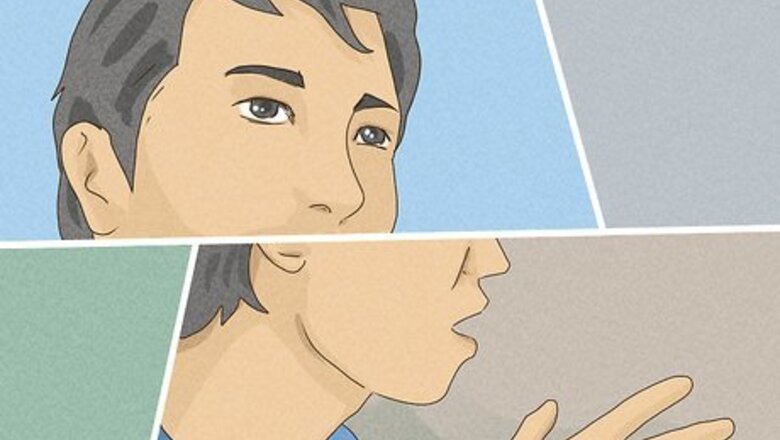
views
Changing Your Conversational Habits

Monitor yourself so you don’t say microaggressions by mistake. Be on the lookout for microaggressions, or conversational statements with racist undertones. Chances are, you may not even realize that you’re saying them! As you go about your usual conversations, think about what you’re about to say before you share your thoughts with someone else. Keep in mind that microaggressions may not be universal to everyone you’re speaking with, and may be interpreted differently among people. Microaggressions can be split into 3 main categories: microassaults, microinsults, and micro invalidations. Microassaults are direct comments with racist intent, like racist jokes. If you’ve participated in microaggressions before, that doesn’t make you a bad person! It can be easy to say unprofessional things by mistake if you don’t make an extra effort to filter through your thoughts.

Equate micro assaults to blatantly racist language and actions. Blatant racial slurs and insults fall into this category, and should be avoided at all costs. This is the most obvious type of microaggression to identify. For instance, if you work at a coffee shop and intentionally serve a white person before a person of color, then you’re performing a micro assault.
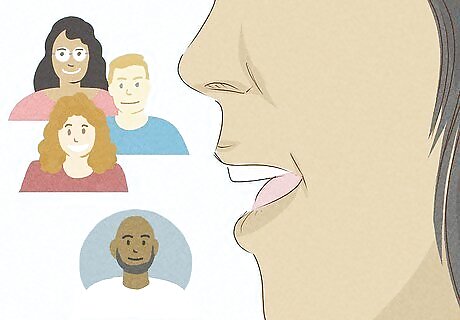
Identify micro insults as subtle attacks on another person. Keep an eye out for in your daily language, which are direct jabs at a person’s capabilities. Even if you don’t mean any harm with your statement, microinsults offer nothing productive to the conversation and will only make you sound prejudiced in the long run. For instance, singling out a person of color and saying they sound articulate or professional is considered a micro insult.

Avoid using microinvalidations to lessen other people’s pain. Micro invalidations are statements that minimize the struggles that minority groups face regularly. When you act like someone’s experiences and prejudices aren’t that bad compared to your own, you’re using microinvalidations. Instead, take time to really listen and support those around you. For instance, mentioning that a cop pulled you over for speeding during a conversation about police brutality is a micro invalidation.

Stop laughing at racist jokes. Racist jokes are uncomfortable for everyone involved, and it’s perfectly understandable if you’d like to laugh off the discomfort temporarily. However, if you laugh or acknowledge an offensive joke in a semi-positive way, the original speaker will think that you’re approving of their humor. Instead, take a moment to let the person know that the joke wasn’t funny, and that racist jokes are harmful to the groups they poke fun at. For instance, you can say something like: “I get that it’s just a joke, but that kind of attitude is really harmful to people of color.”

Call out people who make microaggressions. Listen carefully whenever you’re taking part in a casual conversation. Microaggressions towards minority groups can slip under the radar, so it helps to be alert. Politely pause the conversation and let the speaker know that they said something harmful, even if it wasn’t intended. Explain to them how microaggressions can be hurtful, and why it’s important to leave them out of casual conversation. For instance, asking a person of color where they were born counts as a type of microaggression. In this case, you can say something like: “Who cares? That’s a really impolite thing to ask.”
Adjusting Your Attitude

Speak up when you notice racism occurring. Keep an eye out for racist language or behavior in your everyday conversation. Instead of turning a blind eye, speak up and call out the toxic behavior. This mindset will really set you on a positive, open-minded, and inclusive path. For instance, if someone shares a racist joke, don’t stay silent. Let the joke teller know why their joke is harmful, and how they can improve in the future.

Reprogram yourself to believe that everyone is equal. Without realizing it, you may have internalized biases that prevent you from seeing everyone as equals. While you can’t change your entire worldview overnight, make an effort to redirect and refocus your thoughts to an egalitarian attitude, or an attitude where you believe all people are equal and deserve the same opportunities. Over time, this line of thinking can help let go of racist influences in your thinking patterns and behaviors. For instance, if you believe that you deserve a job opportunity more than the other applicants, pause your train of thought. Instead, think something like: “Everyone is talented and qualified for this job, and they all deserve a fair shot.”
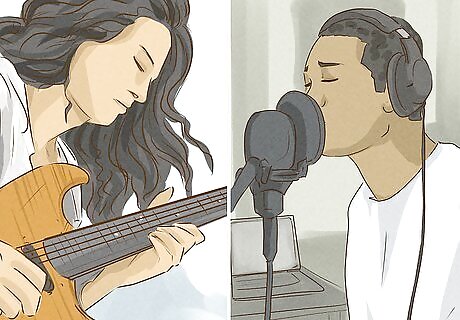
Focus on what you have in common with the people around you. At its core, racism thrives most when people focus on their differences. You can counterattack this by thinking about what you have in common with the people around you. If you get in the habit of positive thinking, you may see a positive change within yourself, too! For instance, you can think something like: “We’re all trying to make the planet a safe, healthy place to live.” You can think something like: “We’re all human beings trying to provide for our families and live our best possible lives.”

Eliminate the concept of “reverse racism” from your mind. Don’t be tempted by the talking point of reverse racism, or the concept that white people can be victims of racism. Keep in mind that racism, by definition, only applies to minority groups that are treated poorly by people with superior attitudes. Pretending that reverse racism exists really minimizes the struggles of other minority communities, and makes you look ill-informed. For instance, from a historical standpoint, legislation, housing, and employment opportunities have been less equal for minority communities.
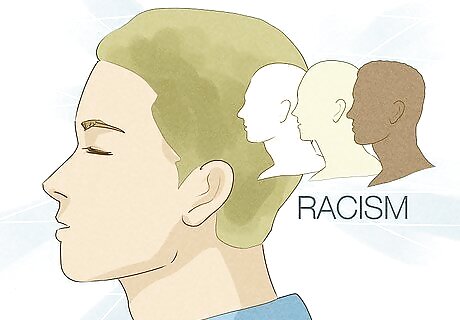
Accept the fact that you may harbor some racist mindsets. Addressing racism can be really difficult, especially if you’re taking a closer look at your own thought patterns. Instead of pretending that your past thoughts and mindsets don’t represent you, take a moment to own up to these thoughts and feelings. Afterwards, you can really commit to living a life without bias! What matters most is that you’re willing to change yourself for the better.

Stay calm if someone calls your behavior racist. Try not get defensive if someone calls you a racist. Instead, do your best to understand how your language or behavior was hurtful. If the other person is willing, ask if they can explain to you what was wrong about what you said. Really take the answer to heart, so you can apply it to your conversations in the future. Remember—you aren’t the enemy. The true enemy in any society and conversation is racism itself.
Talking with Your Kids
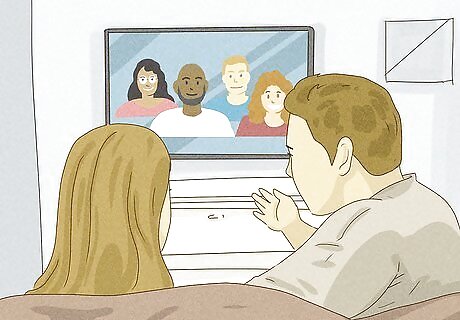
Model respectful behavior and attitudes to your kids at home. Studies show that kids can pick up on racial biases from a very young age, even when they’re toddlers. With this in mind, make an extra effort to be a role model to your children. Don’t make statements that belittle or otherwise invalidate people from other backgrounds—whether you realize it or not, your children are likely watching, listening and picking up on these signals. Instead, stress to your children that everyone deserves to be treated equally and be given the same opportunities. For instance, you can show your kids TV shows and movies that feature a lot of diverse characters.
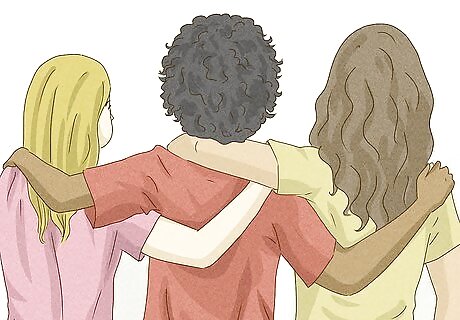
Encourage your children to befriend people from all backgrounds. Being a good role model can only go so far, especially when your child is developing their own view of the world. Invite your kid to make friends with a variety of different kids at school. If your child is exposed to a lot of different cultures, they’ll be far less likely to harbor any racist attitudes or influences. You can set a good example by having a diverse friend group of your own!

Explain what racism is to your child. Racism is a hard discussion to have at any age, especially when you’re talking with a younger audience. Instead of centering the conversation on gritty news stories, focus on celebrating people’s differences. Help your kids understand the basics of racism by explaining basic stereotypes, and why they’re hurtful to other people. For instance, if your young child asks why someone’s skin is lighter or darker, you can say something like: “Everyone is unique and special in their own way.” If you’re speaking with grade-school kids, you can show them books or TV shows where minority groups were represented badly, like shows where minority groups are portrayed as villains.

Turn instances of intolerance into teachable moments. Listen to what your kids say around the home, especially as they start forming their own thoughts and opinions. If your child says something intolerant, don’t immediately discipline them. Instead, take them aside and ask them why they’re thinking in a certain way. Once they’ve given some clarification, gently correct them on how their words can be harmful. For instance, your child comments how a person of color can’t dress up as a Star Wars character for Halloween, explain to them how their opinion is hurtful and unfair to exclude minority groups from popular activities and trends. Remind your child that characters aren’t limited by their race, and that any person can portray those characters in their own way.
Coexisting with Racist People as a Minority

Lean on your friends and family if you’re a victim of racism. It can be really tough to deal with racist, bigoted individuals on a regular basis. If you’re feeling down, talk to a loved one about how you’re feeling, and see if they can offer any support and advice going forward. It may be a lot easier to deal with negativity and prejudice if you know that you’re not alone! You can also speak with a mentor or other trusted person, like a spiritual leader or guidance counselor.
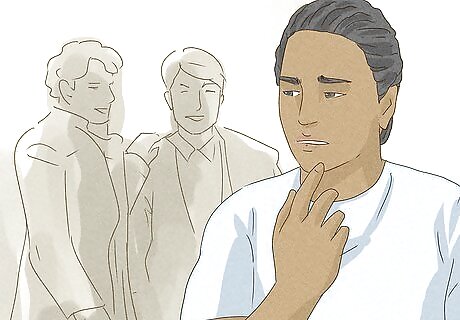
Focus on your own safety before speaking up. It can be really stressful to be surrounded by racist individuals. While speaking up is a good option, your own safety and comfort comes before anything else. Feel free to record blatant, public acts of racism on camera, which you can give to the police instead of worrying about it yourself. Above all else, it’s really important that you feel safe and comfortable before you tackle or address any racist remarks or behaviors.

Address racist behavior as you notice it. Don’t let hurtful comments slide—instead, make a pointed comment to address their remarks. This doesn’t have to be a nasty confrontation. Focus on how you’re feeling, and how their language made you feel. If they seem receptive, consider offering some suggestions for what they could say or do in the future. For instance, you can say something like: “I felt really hurt and devalued when you used the term ‘refugees.’ In the future, consider using a phrase like ‘communities who’ve left their original homes.’”

Reclaim your pride by redefining your negative thoughts. It’s easy to think and feel negatively about something, especially if there are a lot of bigoted people in your community. Instead of dwelling on your negative thoughts, take time to reframe your feelings in a positive, productive way. It can help to give your negative thoughts a reality check before turning them into a positive reminder of sorts. For instance, if you’re thinking something like “I deserve these negative comments from the people around me,” transform your thought into something like: “I’m a worthwhile and valuable person, and I don’t deserve any racist negativity.”


















Comments
0 comment